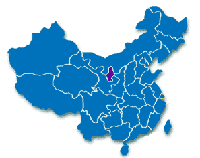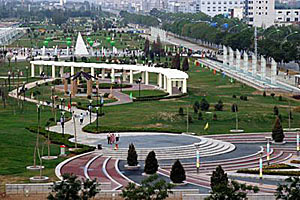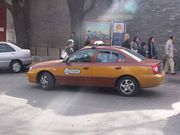Ningxia or the Ningxia Hui Autonomous Region is located on the upper reaches of the Yellow River, in the east of the northwest China. Ningxia Hui Autonomous Region is one of the five autonomous regions in China, and is the smallest of all provinces in China. Ningxia is one of the minority autonomous regions at the provincial level, where people of Hui nationality have inhabited and they make up to 30% of the population. Ningxia is surrounded by Gansu, Shanxi and Inner Mongolia provinces and covers the land area of 66400 Sq. Kms. It governs 3 Municipalities, 1 district, 17 counties and 7 municipal districts. China. Ningxia Hui Autonomous Region is one of the five autonomous regions in China, and is the smallest of all provinces in China. Ningxia is one of the minority autonomous regions at the provincial level, where people of Hui nationality have inhabited and they make up to 30% of the population. Ningxia is surrounded by Gansu, Shanxi and Inner Mongolia provinces and covers the land area of 66400 Sq. Kms. It governs 3 Municipalities, 1 district, 17 counties and 7 municipal districts.
There are the Great Liupan Mountain, the steep Helan Mountain and desert in Ningxia. The Yellow River runs right through the region. Ningxia is also famous for its produce, such as the pearl rice and wolfberry. Thanks to the ancient Huanghe River irrigational system, the northern part of Ningxia is well irrigated and known as the land of fish and rice, in the North.
Capital - Yinchuan
Yinchuan (Phoenix city) is the capital of Ningxia. It is said that, long time ago there were seven sisters of phoenixes and they went on a trip to see beautiful mountains and rivers. After a long flight, they found a green land surrounded by a yellow dessert. The youngest sister was attracted by this beautiful jade-like green land and decided to stay. She said goodbye to her sisters and then landed facing to the Yellow River and tailing on the Helan Mountain. She spread her two wings and turned herself into the beautiful city - Yinchuan.
Yinchuan has a long history as a frontier outpost and trading center and now serve as the region's main industrial, transportation, and administrative and cultural center. Ningxia also boasts of mineral resources, such as sodium, magnesium, hydraulic ammonia, lime nitrogen and niobium. The gas reserves in the " Shan Gan Ning Natural Gas Field" exceeds 290 billion tons and it is one of the largest gas fields in the world
Geography: Situated in the eastern part of the inland northwest, Ningxia is at the Great Bend of the Huanghe River. Located between 104.17° E - 107.38° E longitude and 35.14° N - 39.23° N latitude, northern Ningxia is surrounded by Inner Mongolia while the southern part is bounded by Gansu Province and on the east by Shanxi Province. The whole region is 2,000 meters above sea level, although generally the southern part is higher than the northern. The climate is characterized by cold weather in the south, warmer weather in the north as well as wet weather in the south and dry weather in the north.
Natural Resources: Because of its altitude and cold weather, Ningxia's natural conditions are relatively adverse: in the middle part, there is a large area of dry land and desert. Most of the north is plain; the percentage of forest-covered land is only 4.85%. Soil erosion is commonplace in the region. Thanks to the Huanghe River passing through the Wuyin plain of the North of Ningxia, several sets of ancient irrigation canal built in the Qin and Han Dynasties of about 2,000 years ago are still effective for agriculture.
-
History: Ningxia, a region as culturally rich as the entire area south of the Yangtze River, continues to be admired for its resplendent cultural heritage garnered from the long river of history. During the time of the Tang and Han Dynasties (206 BC - 907 AD) Ningxia was the main place for trade and transportation between the eastern and western regions of ancient China. Ruins of the Great Wall of the Ming Dynasty can be found in east Ningxia
-
Topography: The topography of Ningxia features low in the north and high in the south. In the north is the Ningxia plain with the average height of 1,100 - 1,200 meter above the sea level, called as the Yellow River irrigated region, enjoying the fame of Land flowing with milk and honey as lush southern type field In the south is the southern mountainous area including tableland in Lingwu and Yanchi, the basin in mountains around the Loushan Mount, Loess hills and Liupanshan mountainous region, with the average height of 1,300 ¨C 1,500 meters above the sea level. Generally, Ningxia is the inner land, with the climate of continental variable zone. The average the rainfall around 200 ¨C 400 mm, and reduces gradually from the south to the north. It features long hour of sunshine of about 3,000 hours a year with great gap of temperature during day and night, and the frost-free period is about 170 days.
Distance from Airport
-
Airports: Beijing 472 (2004 est.)
-
Airports - with paved runways: total: 383 over 3,047 m: 53 2,438 to 3,047 m: 116 1,524 to 2,437 m: 141 914 to 1,523 m: 23 under 914 m: 50 (2004 est.)
-
Airports - with unpaved runways: total: 89 over 3,047 m: 5 2,438 to 3,047 m: 4 1,524 to 2,437 m: 13 914 to 1,523 m: 32 under 914 m: 35 (2004 est.)
Transportation:
Off campus:
-
Taxis are relatively cheap and can be picked up outside the college gate at most times of the day. Of course, drivers don’t speak English, so you may need to have the name of the place you are going written in Chinese Characters.
-
There are bus services that run between the town and the school gate. Number 1, 2, 23, 3, 12, which comes from the countryside and drives past the school gate, is the fastest and most direct bus to the city center. Number 1, which starts at the gate of the college (usually green colors) and goes to the city via the railway station. It can be interesting to get on one for a round
- It will cost you 1-2 Yuan each time regardless of the journey, you need the exact change as you put your money into a slot and no change is available.

- Railway station: Taxies and No. 1 buses go there. The railways stretch out to many other provinces or districts. You may buy a Direction Book from the station to check which route is suitable for you if you want to go other places.
-
Long Distance Bus Station: it is Near Ningxia University affiliated Hospital in the city center, Taxies and No. 1 , 2 , 3 buses all go there. The buses at the Long Distance Station run to every district in Yinchuan province, also some places in other provinces (e.g. Shanghai, Wuhan, Nanjing)
- Yinchuan Airport, It’s 40 minutes by bus from Ningxia, the flights go to most of important city around China.
|
Copyrights (C) 2005. Genesis Career Counsellors Pvt. Ltd., All rights reserved. |
|